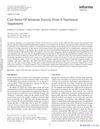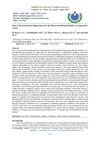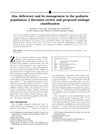A Case of Secondary Diabetes Mellitus Associated with Chronic Arsenic Toxicity
September 2016
in “
Case Reports in Internal Medicine
”
TLDR Chronic arsenic toxicity can cause diabetes and may not improve even with treatment.
A 54-year-old female developed secondary diabetes mellitus (DM) due to chronic arsenic toxicity, presenting with symptoms like fatigue, weight loss, anorexia, colitis, cachexia, skin eruptions, and alopecia. Despite extensive evaluations for other causes, elevated arsenic levels in her serum and urine confirmed the diagnosis. She underwent chelation therapy with British anti-Lewisite (BAL), which lowered arsenic levels but did not lead to clinical improvement as she died shortly after. This case highlighted the importance of considering heavy metal toxicity in unexplained DM cases and suggested the need for further research on treatment efficacy and the potential reversibility of arsenic-induced DM.




